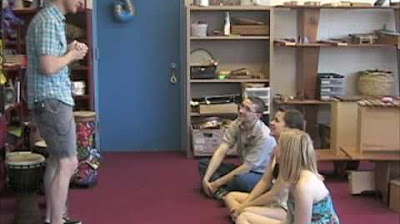What are Orff Instruments?
Summary
TLDRIn this World Drum Club episode, host Kalani introduces Orff instruments, essential tools in Carl Orff's music and movement education approach. These instruments, including xylophones, metallophones, and glockenspiels, are designed for classroom use, featuring a limited range for ease of play. Kalani demonstrates how these instruments can be adapted to create different scales, offering a safe and freeing musical experience. The video also touches on the benefits of Orff certification and the joy of sharing music globally.
Takeaways
- 🎵 Orff instruments are part of the Orff Schulwerk approach, developed by Carl Orff and Gunild Keetman for teaching music and movement to children.
- 🪘 These instruments are categorized into three main types: xylophones (wood), metallophones (metal, like vibraphones), and glockenspiels or bells (metal, higher pitch).
- 🎹 Orff instruments cover a wide pitch range, similar to an entire orchestra, from bass to piccolo.
- 👶 They are designed to be child-friendly, affordable, and easy to move and store, typically with a limited range of one to two octaves.
- 🎶 The instruments are diatonic, often featuring only the white keys of a piano, which simplifies learning and playing for children.
- 🔄 A unique feature of Orff instruments is the ability to modify them by adding or removing bars, allowing for the creation of different scales.
- 🎶 The 'subtractive approach' allows for educational play by removing certain bars to form pentatonic or other scales, ensuring only correct notes are played.
- 🎵 The instruments can be played in various positions, such as sitting on the floor or in a chair, making them versatile for classroom use.
- 🌐 Orff instruments are not just limited to Orff classrooms; they can be integrated with other musical instruments like recorders and percussion.
- 📚 For more information on Orff instruments and the Schulwerk approach, resources like parapool.com and aosiorff.org are recommended.
Q & A
Who is Carl Orff and what is his significance in music education?
-Carl Orff was an Austrian composer who, along with his partner Gunild Keetman, developed an approach to teaching music and movement to children in the mid-1900s in Austria and Germany. Their method has become a worldwide phenomenon and is known as the Orff Schulwerk.
What are Orff instruments?
-Orff instruments are a category of musical instruments that are typically used in the Orff Schulwerk approach to music education. They include barred instruments such as xylophones, metallophones, and glockenspiels.
What are the three main categories of Orff instruments?
-The three main categories of Orff instruments are xylophones (wood instruments), metallophones (metal instruments similar to vibraphones), and glockenspiels or bells (also metal but with a different sound and higher pitch range).
Why are Orff instruments suitable for the classroom?
-Orff instruments are suitable for the classroom because they are designed to be child-friendly, affordable, and easy to move around and store. They typically have a limited range and are often in the diatonic scale, which simplifies learning and playing for children.
What is unique about the design of Orff instruments for learning music?
-Orff instruments are designed with a limited range and can be made simpler by removing or adding bars to create different scales. This allows for a safe and creative learning environment where students can experiment without playing 'wrong' notes.
How do Orff instruments facilitate music learning without music theory knowledge?
-Orff instruments facilitate music learning without music theory knowledge by providing a limited set of notes that create harmonious combinations. By removing or adding bars, students can play scales that are inherently harmonious, allowing for creative exploration without the risk of discordant notes.
What is the 'subtractive approach' mentioned in the script?
-The 'subtractive approach' refers to the method of removing certain bars from Orff instruments to limit the available notes, thus creating different scales. This approach simplifies the instrument for learners and allows for the creation of pentatonic or other non-diatonic scales.
How do Orff instruments contribute to a music education program?
-Orff instruments contribute to music education by providing a hands-on, accessible way for students to engage with music. They encourage creativity, improvisation, and ensemble playing, while also supporting the development of musical skills and understanding.
What additional instruments or elements are often included with Orff instruments in a music education setting?
-In addition to Orff instruments, music education programs often include singing, unpitched percussion like tambourines and shakers, recorders, and other instruments like gongs or cymbals to enrich the musical experience.
Where can one find more information about Orff instruments and the Orff Schulwerk approach?
-For more information about Orff instruments and the Orff Schulwerk approach, one can visit websites like parapool.com, which is a distributor of Orff instruments, or aosi.org, which is related to the Orff Schulwerk movement and offers certification programs.
Outlines

此内容仅限付费用户访问。 请升级后访问。
立即升级Mindmap

此内容仅限付费用户访问。 请升级后访问。
立即升级Keywords

此内容仅限付费用户访问。 请升级后访问。
立即升级Highlights

此内容仅限付费用户访问。 请升级后访问。
立即升级Transcripts

此内容仅限付费用户访问。 请升级后访问。
立即升级浏览更多相关视频

The Orff Approach

MUSIC 10: AFRO-LATIN AMERICAN MUSIC

How Music Can Transform Your Leadership [The Leader’s Playlist]

ALAT KESEHATAN DAN FUNGSINYA (TERLENGKAP PART 2)

Cakewalk by BandLab Tutorial (Part 4) – Virtual Instruments for MIDI

Video Pembelajaran | Kurikulum Nasional | Seni Budaya | Manajemen Musik Seni Musik Kelas X
5.0 / 5 (0 votes)
